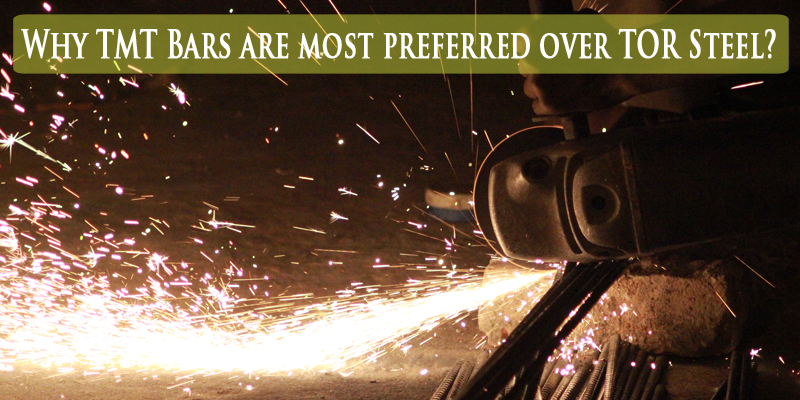Why TMT Bars are Most Preferred Over TOR Steel
Nowadays TOR rebars and TMT steel rebars are broadly utilized in the development of Reinforced Concrete (RC) structures. Following significant boundaries need to be checked and looked at while deciding the nature of any steel rebars.
- Ductility
- Strength
- Flexibility
- Longevity
- Binding
But, at the most one should understand the process and formation of the TOR and TMT Steel rebars which have been explained below:
Manufacturing Process and Formation
TOR Rebars
Predictably, rebars are formed by two separate methods of production. In the initial type, the bars holding ribs at their surface are hot rolled from steel billets along with definite chemical composition to achieve desired strength.
The second one is produced by “Cold Working Process” that includes the stretching and twisting of the Mild Steel (MS) bar of 250 MPa in a repeated manner. Rebars which formed from this are Cold Twisted Deformed (CTD) rebars. On stacking, steel will follow a straight versatile way like that of unique gentle steel till it arrives at where dumping begins; which likewise turns into another “yield point”. The necessary expansion in yield strength is accomplished by suitable determination of dumping point. These rebars are industrially produced under the trademark of “TOR Steel”. This is broadly produced in our country.
TMT Rebars
TMT means “Thermo Mechanically Treated”steel rebars are delivered by applying most recent cutting-edge innovations coming about in undeniably more unrivalled properties than ordinary CTD/TOR rebars.
Thermo mechanical treatment is a high-level heat treatment measure in which hot bars emerging from last moving mill stand are quickly cooled down by an unusual water splash. Quick abolishing gives concentrated cooling that converts surface layer of the bar to a solidified design called “Martensite” and with hot center; Austenite.
The rebars cross‐section with a temperature slope is then permitted to cool in encompassing conditions called “Self-treating”. Upto this stage temperature of center is higher than that of the surface. Warmth is then permitted to move from the center to the surface bringing a hardening surface that gives external surface a strength and durability while center is transformed into a “Soft Ferrite Pearlite”.
Extraordinary Heat Treatment of Quenching and Tempering subsequently changes the design of material to a composite construction of pliable inward center having a construction of “Ferrite Pearlite” and with solid, extreme external surface of “Tempered Martensite”.
This is the manner by which TMT rebars give the novel mix of solidarity and malleability.
Ductility
Ductility is a capability of any fabric / structural factor to deform, except collapse, even after accomplishing the failure load. This property protects the rupture / structural fall down or prolongs the rupture / cave in process. Materials with no ductility are brittle ones. Also, Structures with no ductility give way nearly immediately. It can’t face up to the failure load except surprising collapse. Elongation of a metal rebar refers to capability to elongate earlier than failure.
Strength
Obviously, TMT 500 has greater price of yield energy of 500 MPa to that of the TOR 415 which has yield energy of 415 MPa only. For a utilized load on the structural element, definitely, use of TMT 500 grade consequences in lower metal quantity. It has been determined that use of TOR 415 grade nearly will increase the metal extent through 20 percent to that of the TMT 500 grade.
Flexibility
You can get different shapes of rebars if the rebars have easy internal core. TOR steel has also established track of its flexibility. At the end, good flexibility will help you to give your steel rebars the exact shape which you want.
Longevity
The key parameter in durability of structure is resistance which helps against the rust of the steel rebars. The chemical composition plays a big role in resistance of these TMT rebars. The good quality concrete is a requirement for the rust resistance structure.
Binding
The rebar which consist of low carbon material are highly weldable. To impart strength in rebars, proper amount of carbon distribution is extremely important.
Conclusion
As we can see from the above declaration that TMT Rebars which are produced from the newest technology are providing far improved qualities than standard TOR. It also helps to save almost 20 percent of steel cost. And also, the process of manufacturing TMT are more advanced and classier that changes the nuclear structure to give more strength as well as proper ductility as required.

